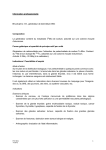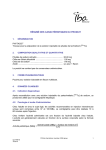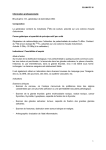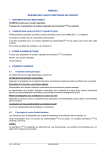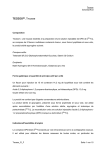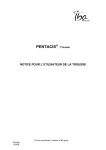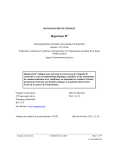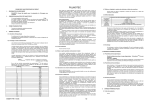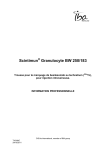Download Monographie du produit
Transcript
216113 ENGLISH DRAXIMAGE® GLUCEPTATE Kit for the Preparation of Technetium Tc 99m Gluceptate Injection (Brain and Kidney Imaging Agent) or Stannous Gluceptate Injection (Cardiac Blood Pool Imaging Agent) DIAGNOSTIC — For Intravenous Use DESCRIPTION The kit consists of reaction vials which contain the sterile, non-pyrogenic, non-radioactive ingredients necessary to produce either Technetium Tc 99m Gluceptate Injection for diagnostic use in kidney and brain imaging or Stannous Gluceptate Injection for diagnostic use in cardiac blood pool imaging. Both diagnostic products are administered by intravenous injection. Each 10 mL reaction vial contains 25 mg of calcium gluceptate† complexed with 3 mg of stannous chloride dihydrate in lyophilized form under an atmosphere of nitrogen. The pH has been adjusted with sodium hydroxide and/or hydrochloric acid. Technetium Tc 99m Gluceptate Injection for Brain and Kidney Imaging The addition of Sodium Pertechnetate Tc 99m Injection to produce Technetium Tc 99m Gluceptate Injection results in the rapid labeling of calcium gluceptate which is essentially quantitative and which remains stable throughout the useful life of the preparation. No bacteriostatic preservative is present. The precise structure of the reaction vial complex or of its technetium labeled form is not known at this time. Tissue Adrenals Bladder wall Bone surfaces Breast GI-tract Stomach wall Small intestine Large intestine wall (upper) Large intestine wall (lower) Kidneys Liver Lungs Ovaries Pancreas Red marrow Spleen Testes Thyroid Uterus Other tissue Effective dose equivalent (mSv/MBq) Table 4 Estimated Absorbed Radiation Doses mGy/MBq 0.0046 0.056 0.0026 0.0014 rad/mCi 0.017 0.21 0.0096 0.0052 0.0027 0.0037 0.0033 0.0044 0.049 0.0027 0.0017 0.0046 0.0036 0.0039 0.0039 0.0029 0.0011 0.0077 0.0023 0.010 0.014 0.012 0.016 0.18 0.010 0.0063 0.017 0.013 0.014 0.014 0.011 0.0041 0.029 0.0085 0.0090 Blood Pool Imaging The estimated absorbed radiation doses4 to various organs of an average patient (70 kg) from an intravenous injection of a maximum dose of 925 MBq (25 mCi ) of Sodium Pertechnetate Tc 99m Injection thirty minutes after the intravenous administration of Stannous Gluceptate Injection are shown in Table 5. Calcium Gluceptate Stannous Gluceptate Injection for Cardiac Blood Pool Imaging The contents of the kit may be reconstituted with sterile, non-pyrogenic preservative-free normal saline to form Stannous Gluceptate Injection for cardiac blood pool imaging and administered 10 to 30 minutes before injecting Sodium Pertechnetate Tc 99m Injection. ACTION Technetium Tc 99m Gluceptate Injection for Brain and Kidney Imaging When injected intravenously, Technetium Tc 99m Gluceptate Injection is rapidly cleared from the blood. The blood clearance curve is tri-exponential with the two faster components accounting for more than 90 % of the injected dose. In patients with normal renal function, less than 15 % of the initial activity remains in the blood after one hour. About 40 % of the injected dose is excreted in the urine in one hour, while about 70 % is excreted in 24 hours. In patients with renal disease, the blood clearance and urine excretion of the radiopharmaceutical are delayed. Up to 15 % of the injected dose is retained in the kidneys with the remainder being excreted in the urine. The renal retention is greater in the cortex than in the medulla. This may be due to the binding of the radiopharmaceutical to the proximal or distal convoluted tubules, which are primarily located in the renal cortex. Technetium Tc 99m Gluceptate Injection tends to accumulate in intracranial lesions with excessive neo-vascularity or an altered blood-brain barrier. It does not accumulate in the choroid plexus or salivary glands. Stannous Gluceptate Injection for Cardiac Blood Pool Imaging When tin, as stannous gluceptate, is injected intravenously, it is taken up by red blood cells and by an unknown mechanism facilitates the labeling of these cells by technetium-99m when the latter is subsequently administered as Sodium Pertechnetate Tc 99m Injection. Following in vivo red blood cell labeling in both normal volunteers and patients, approximately 89 % of the injected dose of Sodium Pertechnetate Tc 99m Injection remained in the intravascular compartment ten minutes post-injection. The blood clearance curve can be resolved into two exponential components; the first may have been due to the extra-vascular distribution and urinary excretion of 99mTc sodium pertechnetate, as well as accumulation of damaged red blood cells by the spleen. About 6 % of the injected dose was excreted in the urine of normal volunteers in 3 hours, and about 28 % was excreted in 24 hours. In five patients with ischemic heart disease however, only about 3 % of the injected dose was excreted in 2 hours, and only about 13 % was excreted in 24 hours. INDICATIONS AND USAGE Technetium Tc 99m Gluceptate Injection may be used to perform kidney and brain imaging, and to assess renal and brain perfusion. Stannous Gluceptate Injection may be used in conjunction with Sodium Pertechnetate Tc 99m Injection for cardiac blood pool imaging. CONTRAINDICATIONS Hypersensitivity to this agent. WARNINGS The contents of the kit before preparation are not radioactive. However, after the Sodium Pertechnetate Tc 99m Injection is added, adequate shielding of the final preparation must be maintained. Radiopharmaceuticals should be used only by or under the control of physicians who are qualified by specific training in the safe use and handling of radionuclides and whose experience and training have been approved by the appropriate government agency authorized to licence the use of radionuclides. Table 5 Estimated Absorbed Radiation Doses rad/25 mCi (10–2 Gy/925 MBq) 1.375 2.750 0.525 0.375 0.375 Organ Blood Urinary bladder wall Ovaries Testes Whole body DOSAGE AND ADMINISTRATION Brain and Kidney Imaging The recommended dose range for intravenous administration of Technetium Tc 99m Gluceptate Injection in the average adult patient (70 kg) is: Renal imaging studies: 370 to 555 MBq (10 to 15 mCi) Brain imaging studies: 555 to 740 MBq (15 to 20 mCi) Dynamic kidney or brain perfusion studies may be performed immediately after injection. Depending on the indication, these may be followed by delayed static imaging one-half to several hours after injection for renal studies, and one to several hours after injection for brain studies. Cardiac Blood Pool Imaging Stannous Gluceptate Complex should be reconstituted with 3.0 mL of sterile, pyrogen-free saline without preservative. A dose of 0.03 mL/kg (16 µg Sn/kg) of body weight (Table 6) is injected intravenously 10 to 30 minutes before intravenous administration of 555 to 925 MBq (15 to 25 mCi) of Sodium Pertechnetate Tc 99m Injection. Therefore, for a 100 kg patient, the entire 3.0 mL is used. For patients weighing less, the exact dose of Stannous Gluceptate Injection may be determined by using the body weight in kilograms as a percentage to calculate the volume required, e.g., for a 70 kg patient, 2.1 mL is required (70 % x 3.0 mL = 2.1 mL). Body Weight (kg) 10 15 20 25 30 35 40 45 50 55 (lb) 22 33 44 55 66 77 88 99 110 121 Table 6 Dose in mL of Stannous Gluceptate Injection by Body Weight Dose Body Weight (mL) (kg) 0.30 60 0.45 65 0.60 70 0.75 75 0.90 80 1.05 85 1.20 90 1.35 95 1.50 100 1.65 (lb) 132 143 154 165 176 187 198 209 220 Dose (mL) 1.80 1.95 2.10 2.25 2.40 2.55 2.70 2.85 3.00 Since adequate reproduction studies have not been performed in animals to determine whether this drug affects fertility in males or females, has teratogenic potential, or has other adverse effects on the fetus, this radiopharmaceutical preparation should not be administered to pregnant or nursing women unless it is considered that the benefits to be gained outweigh the potential hazards. The patient dose of Sodium Pertechnetate Tc 99m Injection should be measured by a suitable calibration system immediately prior to administration. Withdrawals for administration must be made aseptically. Where an assessment of the risk to benefit ratio suggests use of this product in lactating mothers, nursing should be stopped. DIRECTIONS FOR PREPARATION Technetium Tc 99m Gluceptate Injection for Brain and Kidney Imaging Adequate studies do not exist to support the use of this radiopharmaceutical in pediatric patients. As in pregnancy and lactating mothers, the risk to benefit ratio should be assessed before consideration is given to the use of this product in this age group. Ideally, examinations using radiopharmaceuticals, especially those elective in nature, of a woman of childbearing capability should be performed during the first few (approximately 10) days following the onset of menses. PRECAUTIONS The Stannous Gluceptate Injection kit may be used to prepare Technetium Tc 99m Gluceptate Injection for brain and kidney imaging by addition of Sodium Pertechnetate Tc 99m Injection. However, the contents may also be reconstituted with sterile, non-pyrogenic, preservative-free normal saline to form Stannous Gluceptate Injection for cardiac blood pool imaging and administered intravenously 10 to 30 minutes before injecting Sodium Pertechnetate Tc 99m Injection. The components of the kit are sterile and non-pyrogenic. It is essential that the user follows the directions carefully and adheres to strict aseptic procedures during preparation. The 99mTc labeling reactions involved depend on maintaining the tin (stannous ion) in the reduced state. Hence, 99mTc sodium pertechnetate containing oxidants should no be employed. As in the use of any other radioactive material, care should be taken to insure minimal radiation exposure to the patient, consistent with proper patient management, and to insure minimum radiation exposure to occupational workers. Brain and Kidney Imaging The patient should be encouraged to drink fluids before and after the examination. To minimize the radiation dose to the bladder, the patient should be encouraged to void when the imaging procedure is completed and as often thereafter as possible for the next 4 to 6 hours. The image quality may be adversely affected by impaired renal function. Literature reports indicate that the target to non-target ratio for intracranial lesions may take several hours to fully develop, and the possibility of missing certain lesions by restricting imaging to only the early period after injection should be borne in mind. Blood Pool Imaging Stannous Gluceptate Injection should be administered by direct venipuncture. Heparinized catheter systems must be avoided. When the cardiac blood pool is imaged, the patient’s cardiac condition should be stable. Imaging in conjunction with stress-exercise should be conducted under the supervision of an experienced cardiologist in an examination room equipped with an ECG recorder, a defibrillator and standard resuscitation equipment. Similarly, during the scanning procedure of patients with known or suspected myocardial infarction, the required clinical supervision and supportive therapy must be maintained. Subsequent re-administration of Sodium Pertechnetate Tc 99m Injection within one week after a cardiac blood pool imaging procedure will re-label some of the red blood cells. Therefore, if an imaging procedure using Sodium Pertechnetate Tc 99m Injection is anticipated, this examination should be carried out prior to the use of Stannous Gluceptate Injection or not less than one week after the administration of the drug. ADVERSE REACTIONS Although adverse reactions have not been reported that are specifically attributable to the use of Technetium Tc 99m Gluceptate Injection, allergic dermatological manifestations (erythema) have been infrequently reported with similar agents. PHARMACOLOGY Technetium Tc 99m Gluceptate Injection for Brain and Kidney Imaging Intravenous administration of Technetium Tc 99m Gluceptate Injection to rats resulted in rapid clearance of the drug from the blood pool with less than 3 % of the injected dose remaining in the circulation at 1 hour post-injection. The kidney retention of the radiopharmaceutical was approximately 12 % of the dose, which decreased slowly to less than 8 % within 24 hours. A similar pattern was observed in rabbits except that the kidney retention was lower and the blood clearance was slower. About half of the injected dose was excreted in the urine within the first hour post-injection. Stannous Gluceptate Injection for Cardiac Blood Pool Imaging In a dose range study, rabbits were injected with doses of Stannous Gluceptate Injection containing between 2.6 and 31.6 µg of tin. The following table indicates the percentage of labeled red blood cells with the increasing dose of tin. Tin % Labeled RBC (µg/kg body weight) 2.6 86.3 5.3 93.6 10.5 95.5 15.8 95.3 31.6 96.2 NOTE: Use aseptic procedures throughout and take precautions to minimize radiation exposure by use of suitable shielding. Before reconstituting a vial, it should be inspected for cracks and/or a melted plug or any other indication that the integrity of the vacuum seal has been lost. To prepare Technetium Tc 99m Gluceptate Injection: 1. Remove the protective disc from a reaction vial and swab the closure with an alcohol swab. 2. Place the vial in a suitable radiation shield. Obtain 2 to 10 mL of Sodium Pertechnetate Tc 99m Injection using a shielded syringe. The recommended maximum amount of technetium-99m to be added to a reaction vial is 11.1 GBq (300 mCi). 99mTc sodium pertechnetate containing an oxidizing agent is not suitable for use. 3. Add the Sodium Pertechnetate Tc 99m Injection to the reaction vial aseptically. 4. Agitate the shielded vial until the contents are completely dissolved. Using proper shielding, the vial should be visually inspected and not used if there is evidence of particulate or foreign matter. To ensure maximum tagging, allow the preparation to stand at room temperature (15 °C to 30 °C) for 15 minutes after mixing. 5. Assay the product in a suitable calibrator, record the radioassay information on the label with a radiation warning symbol, and apply it to the vial shield. 6. The radiochemical purity of the finished preparation should be checked prior to patient administration. The radiochemical purity should not be less than 90 %. 7. Withdrawals for administration must be made aseptically using a sterile syringe and needle. Since the vials contain nitrogen to prevent oxidation of the complex, the vials should not be vented. If repeated withdrawals are made, minimize the replacement of the contents with room air. 8. The finished preparation should be stored at 2 °C to 8 °C when not in use and discarded after 8 hours. Stannous Gluceptate Injection for Blood Pool Imaging NOTE: Use aseptic procedures throughout. To prepare Stannous Gluceptate Injection: 1. Remove the protective disc from a reaction vial and swab the closure with an alcohol swab. 2. Add 3.0 mL of sterile, non-pyrogenic, preservative-free normal saline to the reaction vial aseptically. 3. Agitate the vial until the contents are completely dissolved. The vial should be visually inspected and not used if there is evidence of particulate or foreign matter. 4. Withdrawals for administration must be made aseptically using a sterile syringe and needle. Since the vials contain nitrogen to prevent oxidation of the complex, the vials should not be vented. If repeated withdrawals are made, minimize the replacement of the contents with room air. 5. The finished preparation should be stored at 2 °C to 8 °C when not in use and discarded after 8 hours. The 99mTc pertechnetate eluate should be less than 2 hours old and should be obtained from a generator which has been eluted within the last 24 hours. Radiochemical Purity Chromatographic Methods The following procedure describes a series of simple steps for running chromatograms. Steps 1 to 6 describe the method for determining free pertechnetate in a mixture of chelated and reduced technetium. The TLC procedure requires the following: Solid phase: ITLC-SG Solvent: Acetone (for determination of pertechnetate) Step 1 Add 1 mL of the required solvent to an 18 mm x 150 mm test tube. Stopper and allow the atmosphere in the tube to equilibrate for 1 minute. Step 2 Prepare one chromatography strip (1 x 10 cm) of silica gel impregnated glass fiber sheets (ITLC type SG). Apply one small drop (~ 20 000 cpm) of the radioactive gluceptate solution to the origin at 1.5 cm from one end and dry under a nitrogen jet. Step 3 Develop the chromatogram by placing it, with the origin down, in the previously equilibrated test tube. Stopper the test tube. The test tube should be kept upright, ideally in a test tube rack. Development requires about 10 minutes for ITLC-SG strips. Step 4 When the solvent front has climbed to the top of the strip, remove it with forceps and allow it to dry. The strips can be dried by placing them radioactive side up on a disposable non-porous pad at room temperature. The bound and reduced technetium appear at the origin or Rf 0 and the free pertechnetate 99mTcO4– migrates to the front at Rf 0.85 to 1.0. Step 5 Cut the dried strip 2 cm from the solvent front end. The short piece is marked Part II and the long piece is marked Part I. Count the pieces in a suitable counter and determine the percentage of free perctechnetate according to the following formula: Counts in Part II X 100 Percent 99mTcO4– = Counts Part I + Part II Step 6 Store all waste radioactive strips for 48 hours before disposing of them as non-radioactive waste. Store used chromatographic solvents in a similar fashion. Therefore, a dose of 16 µg of tin per kilogram of body weight is considered optimal for red blood cell labeling. When in vivo red blood cell labeling is performed in rats, not less than 90 % of the injected dose of Sodium Pertechnetate Tc 99m Injection remains in the blood thirty minutes after injection. More than 98 % of the radioactivity in the blood is associated with the red blood cells and there is a minimal loss of the label over a 6-hour period. HOW SUPPLIED DRAXIMAGE® GLUCEPTATE Kit for the Preparation of Technetium Tc 99m Gluceptate Injection or Stannous Gluceptate Injection Product No. 500220 TOXICOLOGY A safety assessment in two rodent and one non-rodent species was made using Stannous Gluceptate Injection reconstituted with saline but without any 99mTc sodium pertechnetate. The kit consists of 5 vials of stannous gluceptate complex, each vial containing in lyophilized form under an atmosphere of nitrogen: Calcium gluceptate 25 mg Stannous chloride dihydrate 3 mg The acute intravenous lethal dose50 (LD 50) of Stannous Gluceptate Injection in Swiss Albino mice is 605 mg/kg body weight, and 440 mg/kg in BBL Sprague-Dawley rats. The signs of acute intoxication in mice were moderate respiratory depression and clonic-tonic convulsions shortly after drug administration. No signs of acute drug intoxication were observed in rats. The pH has been adjusted with sodium hydroxide and/or hydrochloric acid. A slow intravenous injection of 56 mg Stannous Gluceptate Injection (6 mg stannous chloride dihydrate) per kg body weight in four beagle dogs produced no toxic or gross pathological changes. This dose represents a 200 fold excess over the human dose (0.28 mg/kg). STORAGE Store kit at or below room temperature. Do not use the kit beyond the expiry date stamped on the box. PHYSICAL CHARACTERISTICS Technetium-99m decays by isomeric transition with a physical half-life of 6.02 hours.1 The principal photon that is useful for detection and imaging studies is listed in Table 1. REFERENCES 1. Martin, M.J., Ed. Nuclear Decay Data for Selected Radionuclides, ORNL Report No. 5114, page 24, March 1976. 2. Arnold, R. W., et al., Comparison of 99mTc Complexes for Renal Imaging J. Nucl. Med. 16: 357, 1975. 3. Radiation Internal Dose Information Center, Oak Ridge Associated Universities, Oak Ridge, TN, Jan. 5, 1977. 4. Calculated by Mr. Jack L. Coffey, Radiation Internal Dose Information Center, Oak Ridge Associated Universities, Oak Ridge, TN. Radiation Gamma-2 Table 1 Principal Radiation Emission Data Mean % per Disintegration 89.07 Mean Energy (keV) 140.5 The specific gamma ray constant for technetium-99m is 5.44 µCOkg–1OMBq–1Ohr–1 (0.78 R/mCi-hr) at 1 cm. The half-value layer is 0.2 mm of Pb. To facilitate control of the radiation exposure from millicurie amounts of this radionuclide, the use of 2.5 mm thickness of Pb will attenuate the radiation emitted by a factor of about 1 000. Table 2 Radiation Attenuation by Lead Shielding Shield Thickness (Pb) mm 0.2 0.8 1.6 2.5 3.3 4.5 Labels with a radiation warning symbol and (directions) product monograph are supplied with each kit. Revised: December 2012 Jubilant DraxImage Inc. Kirkland Quebec H9H 4J4 Canada Draximage ® is a Registered Trademark of Jubilant DraxImage Inc. Coefficient of Attenuation 0.5 10-1 10-2 10-3 10-4 10-5 To correct for physical decay of this radionuclide, the fractions that remain at selected intervals after the time of calibration are shown in Table 3. Hours 0* 1 2 3 4 Fraction Remaining 1.000 0.891 0.794 0.708 0.631 Table 3 Physical Decay Chart of Technetium-99m Half-Life: 6.02 Hours Hours Fraction Remaining 5 0.562 6 0.501 7 0.447 8 0.398 9 0.355 Hours 10 11 12 18 24 Fraction Remaining 0.316 0.282 0.251 0.126 0.063 *Calibration Time RADIATION DOSIMETRY Brain and Kidney Imaging The estimated absorbed radiation doses2,3 to various organs of an average adult patient (70 kg) from an intravenous injection of a maximum dose of 740 MBq (20 mCi) of Technetium Tc 99m Gluceptate Injection are shown in Table 4. † USP/USAN term for glucoheptonate 216113.indd 1 216113 2013/05/23 1:48 PM FRANÇAIS DRAXIMAGE GLUCEPTATE MD Trousse pour la préparation du gluceptate injectable marqué au technétium-99m (Agent pour la scintigraphie cérébrale et rénale) ou du gluceptate-chlorure stanneux injectable (Agent pour la scintigraphie du réservoir sanguin cardiaque) DIAGNOSTIQUE — Pour voie intraveineuse DESCRIPTION La trousse contient des fioles qui renferment les réactifs stériles, apyrogènes et non radioactifs nécessaires soit à la préparation du gluceptate injectable marqué au technétium-99m pour la scintigraphie cérébrale et rénale, soit à la préparation du gluceptate-chlorure stanneux injectable pour la scintigraphie du réservoir sanguin cardiaque. Ces produits sont réservés à l’usage diagnostique et doivent être administrés par voie intraveineuse. La fiole de réaction de 10 mL renferme 25 mg de gluceptate† de calcium et 3 mg de chlorure stanneux dihydraté sous forme lyophilisée et sous atmosphère d’azote. Le pH a été ajusté par l’addition d’hydroxyde de sodium et/ou d’acide chlorhydrique. Gluceptate injectable marqué au technétium-99m pour la scintigraphie cérébrale et rénale L’addition de Pertechnétate de Sodium Tc 99m Injectable produit un marquage rapide et essentiellement quantitatif du gluceptate de calcium qui demeure stable pendant toute la période active de la substance. La préparation ne renferme pas d’agent bactériostatique. On ne connaît pas encore la structure précise du complexe de la fiole de réaction ni celle du technétium marqué. Tissu Surrénales Paroi vésicale Surfaces osseuses Seins Tractus gastro-intestinal Paroi gastrique Intestin grêle Paroi côlon ascendant Paroi côlon descendant Reins Foie Poumons Ovaires Pancréas Mœlle rouge Rate Testicules Thyroïde Utérus Autres tissus Dose efficace équivalente (mSv/MBq) Tableau 4 Estimation des doses d’irradiation absorbées mGy/MBq 0,0046 0,056 0,0026 0,0014 rad/mCi 0,017 0,21 0,0096 0,0052 0,0027 0,0037 0,0033 0,0044 0,049 0,0027 0,0017 0,0046 0,0036 0,0039 0,0039 0,0029 0,0011 0,0077 0,0023 0,010 0,014 0,012 0,016 0,18 0,010 0,0063 0,017 0,013 0,014 0,014 0,011 0,0041 0,029 0,0085 0,0090 Scintigraphie du réservoir sanguin cardiaque Le tableau 5 présente les estimations des doses d’irradiation4 qui peuvent être absorbées par divers organes ou tissus chez un adulte de poids moyen (70 kg) après une injection intraveineuse maximale de 925 MBq (25 mCi) de Pertechnétate de Sodium Tc 99m Injectable trente minutes après l’administration intraveineuse de gluceptate-chlorure stanneux injectable. Tableau 5 Doses estimées de rayonnement absorbé Gluceptate de calcium Gluceptate-chlorure stanneux injectable pour la scintigraphie du réservoir sanguin cardiaque Les substances contenues dans la trousse peuvent être reconstituées avec un soluté physiologique stérile, apyrogène, ne contenant pas d’agent de conservation afin de former du gluceptate-chlorure stanneux injectable pour la scintigraphie du réservoir sanguin cardiaque. Cette préparation doit être administrée par voie intraveineuse 10 à 30 minutes avant l’injection du 99mTc pertechnétate de sodium. action Gluceptate injectable marqué au technétium-99m pour la scintigraphie cérébrale et rénale Après une administration intraveineuse, le gluceptate injectable marqué au technétium-99m est rapidement éliminé du sang. L’élimination sanguine se traduit par une courbe triexponentielle : les deux composantes les plus rapides interviennent pour plus de 90 % de la dose injectée. Chez les patients dont la fonction rénale est normale, moins de 15 % de la radioactivité initiale du produit se trouve encore dans le sang une heure après l’injection. Environ 40 % de la dose injectée est excrétée dans l’urine en une heure, tandis qu’environ 70 % est excrétée en 24 heures. L’élimination sanguine et l’excrétion urinaire du produit radiopharmaceutique se font plus lentement chez les patients atteints de néphropathie. Jusqu’à 15 % de la dose injectée est retenu dans les reins et le reste de la dose est éliminé dans l’urine. La rétention rénale de la substance radioactive est plus élevée dans le cortex que dans la substance médullaire. Ce phénomène peut être attribuable à la fixation du produit radiopharmaceutique dans les tubes contournés proximaux ou distaux principalement situés dans le cortex rénal. Le gluceptate injectable marqué au technétium-99m a tendance à s’accumuler dans les lésions intracrâniennes accusant une néovascularité excessive ou encore une atteinte de la barrière hémato-encéphalique. On ne relève aucune accumulation de la substance dans les plexus choroïdes ni dans les glandes salivaires. Gluceptate-chlorure stanneux injectable pour la scintigraphie du réservoir sanguin cardiaque Après une administration intraveineuse, l’étain, sous forme de gluceptate-chlorure stanneux, est absorbé par les érythrocytes et, par un mécanisme inconnu, il facilite le marquage de ces cellules par le technétium-99m lorsque ce dernier est ensuite administré sous forme de Pertechnétate de Sodium Tc 99m Injectable. Après le marquage des érythrocytes in vivo tant chez des volontaires sains que chez des patients, environ 89 % de la dose injectée de Pertechnétate de Sodium Tc 99m Injectable est demeuré dans le compartiment intravasculaire 10 minutes après l’injection. L’élimination sanguine peut se traduire par une courbe biexponentielle : le premier facteur peut être attribuable à la diffusion du 99mTc pertechnétate de sodium dans les espaces extravasculaires, à l’élimination urinaire et à l’accumulation splénique des érythrocytes altérés. Environ 6 % de la dose injectée a été excrétée en 3 heures dans l’urine de volontaires sains et environ 28 % l’a été en 24 heures. Chez cinq patients atteints de cardiopathie ischémique, seulement 3 % environ de la dose injectée a été excrétée en 2 heures et 13 % environ l’a été en 24 heures. INDICATIONS Le gluceptate injectable marqué au technétium-99m peut servir à la scintigraphie rénale et cérébrale, ainsi qu’à l’étude de la perfusion rénale et cérébrale. Le gluceptate-chlorure stanneux injectable administré conjointement avec du pertechnétate de sodium Tc 99m injectable peut servir à la scintigraphie du réservoir sanguin cardiaque. CONTRE-INDICATIONS Hypersensibilité à cet agent. MISES EN GARDE Le contenu de la trousse avant reconstitution n’est pas radioactif. Cependant, une fois le 99mTc pertechnétate de sodium ajouté, conserver la préparation dans un blindage approprié. L’utilisation et la manipulation des produits radiopharmaceutiques doivent être réservées à des médecins qualifiés qui, en vertu de leur formation et de leur expérience, détiennent une licence d’un organisme d’État autorisé à sanctionner l’usage des radionucléides. Aucune étude n’a été effectuée chez l’animal pour établir si ce produit peut affecter la fertilité tant du mâle que de la femelle, ni s’il est préjudiciable au fœtus. Ce produit radiopharmaceutique ne doit être administré à des femmes enceintes ou allaitant que si les avantages escomptées dépassent de loin les risques que pourrait comporter cette technique. Si l’évaluation des avantages et des risques justifie l’administration de ce produit à une mère nourrice, on demande à celle-ci de cesser l’allaitement. Aucune étude ne permet de préconiser l’administration de ce produit radiopharmaceutique à des patients en pédiatrie. Tout comme pour les femmes enceintes et les mères nourrices, il faut évaluer tant les risques que les avantages avant d’administrer le produit à cette catégorie de sujets. Chez la femme en âge de procréer, il est préférable de faire passer la scintigraphie, surtout si celle-ci peut être différée, dans les quelques jours (à peu près 10) qui suivent le début des règles. PRÉCAUTIONS La trousse du complexe de gluceptate-chlorure stanneux peut servir à la préparation du gluceptate injectable marqué au technétium-99m pour la scintigraphie cérébrale et rénale en y ajoutant du Pertechnétate de Sodium Tc 99m Injectable. Les substances contenues dans la trousse peuvent toutefois être reconstituées avec un soluté physiologique stérile, apyrogène, ne contenant pas d’agent de conservation afin de former du gluceptate-chlorure stanneux injectable pour la scintigraphie du réservoir sanguin cardiaque. On peut administrer la préparation par voie intraveineuse 10 à 30 minutes avant l’injection du 99mTc pertechnétate de sodium. Le contenu de la fiole est stérile et apyrogène. Il est essentiel que l’utilisateur suive scrupuleusement le mode d’emploi et qu’il observe des mesures d’asepsie rigoureuses. L’efficacité de marquage du technétium-99m dépend des conditions de conservation de l’ion stanneux à l’état réduit. Le 99mTc pertechnétate de sodium utilisé ne devrait contenir aucun agent oxydant. Comme c’est le cas pour l’utilisation de tout produit radiopharmaceutique, il faut prendre les précautions qui s’imposent afin de réduire au minimum la radioexposition du personnel clinique. Il faut également user de prudence afin que le patient ne soit exposé qu’à la quantité de radioactivité nécessaire pour évaluer son état. Scintigraphie cérébrale et rénale On doit encourager le patient à boire des liquides avant et après l’examen. Afin de réduire au minimum la dose de rayonnement absorbée par la vessie, on conseillera au patient d’uriner immédiatement après l’examen et aussi souvent que possible dans les 4 à 6 heures qui suivent. La qualité des scintigraphies peut être altérée chez les patients atteints d’insuffisance rénale. Selon la documentation, il se peut que plusieurs heures soient nécessaires avant que le rapport tissu/milieu environnant des lésions intracrâniennes n’apparaisse d istinctement sur la scintigraphie. Il faut donc se rappeler que l’on risque de ne pas voir toutes les lésions si l’on réalise la scintigraphie seulement pendant la période qui suit immédiatement l’injection. Scintigraphie du réservoir sanguin cardiaque Administrer le gluceptate-chlorure stanneux injectable par ponction veineuse. Éviter l’emploi d’un cathéter héparinisé. Veillez à ce que l’état cardiaque du patient soit stable pendant la scintigraphie du réservoir sanguin cardiaque. La scintigraphie et l’épreuve stress-effort doivent être effectuées sous la surveillance d’un cardiologue expérimenté dans une salle d’examen pourvue d’un électrocardiographe, d’un défibrillateur et d’un réanimateur standard. Une surveillance clinique et un traitement d’appoint s’imposent pendant la scintigraphie de patients chez qui l’on soupçonne ou chez qui l’on a dépisté un infarctus du myocarde. L’administration subséquente de Pertechnétate de Sodium Tc 99m Injectable dans la semaine qui suit la scintigraphie du réservoir sanguin cardiaque aura pour effet de marquer de nouveau certains des érythrocytes. Par conséquent, si une scintigraphie à l’aide du 99mTc pertechnétate de sodium est jugée nécessaire, il faut l’effectuer soit avant l’administration de gluceptate-chlorure stanneux injectable ou au moins une semaine après l’administration du produit. RÉACTIONS DÉFAVORABLES Bien que l’on n’ait pas observé de réactions défavorables directement reliées à l’utilisation du gluceptate injectable marqué au technétium-99m, des manifestations dermatologiques de nature allergique (érythème) ont rarement été signalées avec d’autres agents semblables. PHARMACOLOGIE Gluceptate injectable marqué au technétium-99m pour la scintigraphie cérébrale et rénale Suite à l’administration intraveineuse du gluceptate injectable marqué au technétium-99m chez des rats, on constate que le médicament s’élimine rapidement du réservoir sanguin; en effet, il reste moins de 3 % de la dose une heure après l’injection. Environ 12 % de la dose du produit radiopharmaceutique est retenue par le rein, et ce pourcentage décroît lentement à moins de 8 % en 24 heures. Chez le lapin, le schéma est à peu près le même, bien que la rétention rénale soit plus faible et l’élimination sanguine plus lente. Environ la moitié de la dose injectée est excrétée dans l’urine au cours de l’heure qui suit l’injection. Gluceptate-chlorure stanneux injectable pour la scintigraphie du réservoir sanguin cardiaque Dans une étude effectuée à partir de différentes doses, les lapins ont reçu une injection de gluceptate-chlorure stanneux renfermant de 2,6 à 31,6 µg d’étain. Le tableau suivant indique le pourcentage des érythrocytes marqués et la dose croissante d’étain. Étain % des érythrocytes marqués (µg/kg de poids corporel) 2,6 86,3 5,3 93,6 10,5 95,5 15,8 95,3 31,6 96,2 Tissu Sang Paroi vésicale Ovaires Testicules Organisme entier rad/25 mCi (10-2 Gy/925 MBq) 1,375 2,750 0,525 0,375 0,375 POSOLOGIE ET ADMINISTRATION Scintigraphie cérébrale et rénale La gamme posologique recommandée par voie intraveineuse de gluceptate injectable marqué au technétium-99m chez l’adulte de poids moyen (70 kg) est de : Scintigraphie rénale : 370 à 555 MBq (10 à 15 mCi) Scintigraphie cérébrale : 555 à 740 MBq (15 à 20 mCi) On peut effectuer des scintigraphies dynamiques de la perfusion rénale ou cérébrale immédiatement après l’injection. Selon le cas, il est préférable d’attendre une demi-heure à plusieurs heures après l’injection pour exécuter les scintigraphies statiques pour l’étude rénale et une heure à plusieurs heures après l’injection pour l’étude cérébrale. Scintigraphie du réservoir sanguin cardiaque Reconstituer le complexe de gluceptate-chlorure stanneux dans 3,0 mL de soluté physiologique stérile, apyrogène et sans agent de conservation. Injecter par voie intraveineuse une dose de 0,03 mL/kg (16 µg Sn/kg) de poids corporel (tableau 6) 10 à 30 minutes avant l’administration intraveineuse de 555 à 925 MBq (15 à 25 mCi) de Pertechnétate de Sodium Tc 99m Injectable. Ainsi, il faut administrer une pleine dose de 3,0 mL à un patient de 100 kg. Si le poids est inférieur à 100 kg, calculer la dose exacte de gluceptate-chlorure stanneux injectable en utilisant le poids corporel en kilogrammes comme pourcentage. Par exemple, un patient de 70 kg nécessiterait une dose de 2,1 mL (70 % x 3,0 mL = 2,1 mL). Poids corporel (kg) 10 15 20 25 30 35 40 45 50 55 Tableau 6 Doses en mL de gluceptate-chlorure stanneux injectable en fonction du poids corporel Dose Poids corporel (lb) (mL) (kg) (lb) 22 0,30 60 132 33 0,45 65 143 44 0,60 70 154 55 0,75 75 165 66 0,90 80 176 77 1,05 85 187 88 1,20 90 198 99 1,35 95 209 110 1,50 100 220 121 1,65 Dose (mL) 1,80 1,95 2,10 2,25 2,40 2,55 2,70 2,85 3,00 On doit mesurer la dose de Pertechnétate de Sodium Tc 99m Injectable destinée au patient au moyen d’un appareil de mesure approprié immédiatement avant de la lui administrer. Se conformer à des mesures d’asepsie. MODE D’EMPLOI Gluceptate injectable marqué au technétium-99m pour la scintigraphie cérébrale et rénale NOTE : Se conformer à des mesures d’asepsie et minimiser la radioexposition par l’utilisation d’un blindage approprié. Avant de procéder à la reconstitution de son contenu, l’utilisateur doit procéder à une inspection sommaire de la fiole afin de s’assurer qu’il n’y a aucune présence de fissures et que l’aspect solide de la pastille est intact confirmant ainsi que le produit est toujours conservé sous pression réduite. Pour la préparation du gluceptate injectable marqué au technétium-99m : 1. Retirer l’embout protecteur d’une fiole de réaction et nettoyer le bouchon avec un tampon imbibé d’alcool. 2. Placer la fiole dans un blindage approprié. Prélever, au moyen d’une seringue blindée, de 2 à 10 mL de Pertechnétate de Sodium Tc 99m Injectable. On recommande de ne pas ajouter plus de 11,1 GBq (300 mCi) de technétium-99m à la fiole de réaction. Ne pas utiliser du pertechnétate de sodium 99mTc qui contient un oxydant. 3. Ajouter, au moyen de méthodes aseptiques, le Pertechnétate de Sodium Tc 99m Injectable à la fiole de réaction. 4. Agiter la fiole blindée jusqu’à ce que le liquide soit homogène. Procéder à un examen visuel de la fiole, à l’aide d’un blindage approprié, pour s’assurer que la solution est exempte de corps étrangers; si ce n’est pas le cas, ne pas utiliser la préparation. Pour obtenir un marquage maximal, laisser reposer la préparation durant 15 minutes après le mélange à température pièce (15 °C à 30 °C). 5. Mesurer la radioactivité de la préparation au moyen d’un compteur approprié. Inscrire les données relatives à la radioactivité sur l’étiquette qui porte le symbole de mise en garde contre la radioactivité et la fixer sur le blindage de la fiole. 6. Vérifier la pureté radiochimique de la préparation finale avant de l’administrer au patient. La pureté radiochimique ne doit pas être moins de 90 %. 7. Effectuer de façon aseptique les prélèvements en vue de l’administration de la solution, en se servant d’une seringue et d’une aiguille stériles. Étant donné que les fioles renferment de l’azote, il ne faut pas que de l’air s’y introduise. Par conséquent, si l’on doit effectuer plusieurs prélèvements, faire en sorte que le moins d’air ambiant possible pénètre dans la fiole. 8. Conserver la préparation finale à une température de 2 °C à 8 °C et la jeter 8 heures après sa reconstitution. Gluceptate-chlorure stanneux injectable pour la scintigraphie du réservoir sanguin cardiaque NOTE : Se conformer à des mesures d’asepsie. Pour la préparation du gluceptate-chlorure stanneux injectable : 1. Retirer l’embout protecteur d’une fiole de réaction et nettoyer le bouchon avec un tampon imbibé d’alcool. 2. Ajouter, au moyen de méthodes aseptiques, 3,0 mL de soluté physiologique stérile, apyrogène et sans agent de conservation à la fiole de réaction. 3. Agiter la fiole jusqu’à ce que le liquide soit homogène. Procéder à un examen visuel de la fiole pour s’assurer que la solution est exempte de corps étrangers; si ce n’est pas le cas, ne pas utiliser la préparation. 4. Effectuer de façon aseptique les prélèvements en vue de l’administration de la solution, en se servant d’une seringue et d’une aiguille stériles. Étant donné que les fioles renferment de l’azote, il ne faut pas que de l’air s’y introduise. Par conséquent, si l’on doit effectuer plusieurs prélèvements, faire en sorte que le moins d’air ambiant possible pénètre dans la fiole. 5. Conserver la préparation finale à une température de 2 °C à 8 °C et la jeter 8 heures après sa reconstitution. L’éluat de 99mTc pertechnétate de sodium utilisé ne devrait pas être vieux de plus de deux heures et devrait être obtenu à partir d’un générateur ayant été élué dans les dernières 24 heures. Pureté radiochimique Méthode chromatographique Le mode opératoire suivant décrit une série d’étapes simples pour chromatographie. Les étapes 1 à 6 décrivent la méthode pour déterminer le pertechnétate libre dans un mélange de technétium lié et réduit. La méthode chromatographique sur couche mince requiert : Une phase solide : ITLC-SG Solvant : Acétone (pour la détermination du pertechnétate) Étape 1 Ajouter 1 mL du solvant requis dans une éprouvette de 18 mm par 150 mm. Boucher le tube et laisser l’atmosphère de l’éprouvette se saturer de solvant pendant une minute. Étape 2 Préparer une plaque chromatographique ITLC-SG (1 X 10 cm). Déposer une petite goutte de la solution radioactive de gluceptate (~ 20 000 cpm) sur le point d’origine à 1,5 cm d’une des extrémités de la plaque. Sécher la plaque en la soumettant à un courant d’azote. Étape 3 Développer le chromatogramme en plaçant l’origine vers le bas dans l’éprouvette préalablement saturée. Boucher l’éprouvette et la maintenir droite, idéalement sur un râtelier pour éprouvettes. Le développement prend environ 10 minutes pour les plaques ITLC-SG. Étape 4 Une fois que le front du solvant a atteint le sommet de la plaque, retirer celle-ci de l’éprouvette à l’aide d’une pince et laisser sécher. On peut sécher les plaques à la température ambiante en les plaçant avec le côté radioactif vers le haut sur un tampon jetable non poreux. Le technétium lié et réduit restent à l'origine ou Rf 0 et le pertechnétate libre 99mTcO4– migre avec le front de l'éluant à un Rf de 0,85 à 1,0. Ainsi, une dose de 16 µg d’étain par kilogramme de poids corporel est considérée comme optimale pour le marquage des érythrocytes. Étape 5 Couper la plaque séchée à 2 cm du front de solvant. La partie courte est marquée portion II et la longue, portion I. Mesurer la radioactivité de chacune des pièces dans un compteur approprié et déterminer le pourcentage de pertechnétate libre d’après la formule suivante : Compte de la portion II 99mTcO – en pourcentage = X 100 4 Comptes portion I + portion II Le marquage des érythrocytes in vivo effectué chez des rats a révélé qu’au moins 90 % de la dose injectée de Pertechnétate de Sodium Tc 99m Injectable demeure dans le sang trente minutes après l’injection. Plus de 98 % de la radioactivité dans le sang se lie aux érythrocytes et il se produit une perte minime du marquage sur une période de 6 heures. Étape 6 Entreposer toutes les plaques radioactives durant 48 heures avant de les éliminer comme déchet non radioactif. Conserver les solvants pour chromatographie de la même façon. TOXICOLOGIE L’innocuité du gluceptate-chlorure stanneux injectable dans un soluté physiologique ne contenant pas de 99mTc pertechnétate de sodium a été évaluée sur trois espèces animales dont deux étaient des rongeurs. PRÉSENTATION DRAXIMAGE MD GLUCEPTATE Trousse pour la préparation du gluceptate injectable marqué au technétium-99m ou du gluceptate-chlorure stanneux injectable La dose léthale50 (DL 50) aiguë, par voie intraveineuse, du gluceptate-chlorure stanneux injectable est de 605 mg/kg de poids corporel chez la souris Swiss albinos et de 440 mg/kg chez le rat BBL Sprague-Dawley. Les signes d’intoxication aiguë chez la souris se manifestent par de la dépression respiratoire modérée et des convulsions cloniques et toniques peu après l’administration du produit. Chez les rats, on n’a noté aucun signe d’intoxication aiguë. Une injection intraveineuse lente de 56 mg de gluceptate-chlorure stanneux injectable (6 mg de chlorure stanneux dihydraté) par kg de poids corporel à quatre chiens Beagle n’a produit aucun changement pathologique macroscopique ni toxicologique. Cette dose équivaut à 200 fois la dose pouvant être administrée chez l’homme (0,28 mg/kg). PROPRIÉTÉS PHYSIQUES Le technétium-99m se transforme par transition isomérique et possède une demi-vie de 6,02 heures1. Le principal photon qui peut servir à la détection et à la scinti graphie est indiqué dans le tableau 1. Rayonnement Gamma-2 Tableau 1 Principales données sur l’émission de rayonnements Nombre moyen par 100 désintégrations de photons utilisables 89,07 Énergie moyenne (keV) 140,5 La constante spécifique de rayonnement gamma du technétium-99m est 5,44 µCOkg–1OMBq–1Ohr–1 (0,78 R/mCi-hr) à 1 cm. La couche de demi-atténuation est de 0,2 mm de Pb. Le contrôle de l’exposition à des quantités de radioactivité inférieures à un curie par le technétium-99m est facilité par l’emploi d’un écran de plomb de 2,5 mm d’épaisseur qui a la propriété de réduire cette radiation par un facteur approximatif de 1 000. Tableau 2 Atténuation du rayonnement par un blindage en plomb Épaisseur du blindage (Pb) en mm Coefficient d’atténuation 0,2 0,5 0,8 10-1 1,6 10-2 2,5 10-3 3,3 10-4 4,5 10-5 No du produit 500220 La trousse contient 5 fioles de complexe de gluceptate-chlorure stanneux, chaque fiole renferme sous forme lyophilisée et sous atmosphère d’azote : Gluceptate de calcium 25 mg Chlorure stanneux dihydraté 3 mg Le pH a été ajusté par l’addition d’hydroxyde de sodium et/ou d’acide chlorhydrique. Les étiquettes de mise en garde contre la radioactivité et une monographie sont incluses dans la trousse. ENTREPOSAGE Entreposer la trousse à la température ambiante ou à une température inférieure à celle-ci. Ne pas utiliser la trousse au-delà de la date de péremption imprimée sur la boîte. RÉFÉRENCES 1. Martin, M.J. (réd.), “Nuclear Decay Data for Selected Radionuclides”, ORNL Report No. 5114, mars 1976, p. 24. 2. Arnold, R.W. et coll., “Comparison of 99mTc Complexes for Renal Imaging”. J. Nucl. Med., 16, 1975, p. 357. 3. Radiation Internal Dose Information Center, Oak Ridge Associated Universities, Oak Ridge, Tennessee, le 5 janvier 1977. 4. Calcul effectué par M. Jack L. Coffey, Radiation Internal Dose Information Center, Oak Ridge Associated Universities, Oak Ridge, Tennessee. Revisé : Décembre 2012 Jubilant DraxImage Inc. Kirkland Quebec H9H 4J4 Canada Draximage MD est une marque de commerce déposée de Jubilant DraxImage Inc. Afin de permettre la correction des valeurs de radioactivité en fonction de la décroissance radioactive, le tableau 3 présente les fractions résiduelles à différents intervalles après l’heure du calibrage. Heures 0* 1 2 3 4 Fraction résiduelle 1,000 0,891 0,794 0,708 0,631 Tableau 3 Décroissance radioactive du technétium-99m Demi-vie : 6,02 heures Heures Fraction résiduelle 5 0,562 6 0,501 7 0,447 8 0,398 9 0,355 Heures 10 11 12 18 24 Fraction résiduelle 0,316 0,282 0,251 0,126 0,063 *Heure du calibrage DOSIMÉTRIE DES RAYONNEMENTS Scintigraphie cérébrale et rénale Le tableau 4 présente les estimations des doses d’irradiation2,3 qui peuvent être absorbées par divers organes ou tissus chez un adulte de poids moyen (70 kg) après une injection intraveineuse maximale de 740 MBq (20 mCi) de gluceptate injectable marqué au technétium-99m. MD † Substitué au terme glucoheptonate par les USP/USAN 216113.indd 2 216113 2013/05/23 1:48 PM




